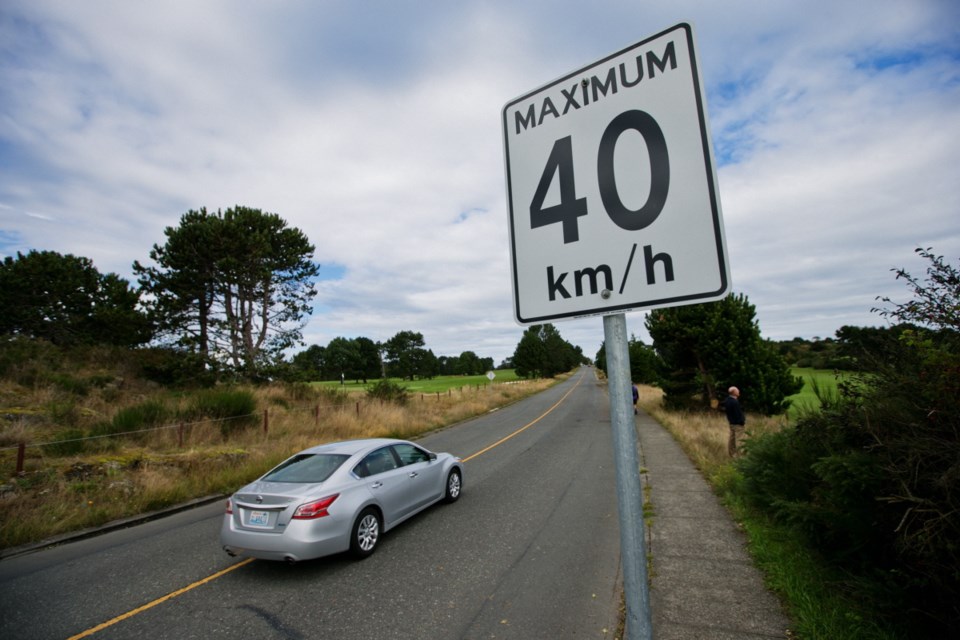Slow down, Victoria you’re moving too fast.
After a town-hall styled public hearing lasting more than two hours Thursday Victoria council has unanimously endorsed a proposal to reduce the speed limit to 40 km/h on a number of city streets and in the downtown core.
Councillors have now directed staff to come up with timelines and a plan for implementation, said Coun. Shellie Gudgeon, who with Coun. Ben Isitt was one of the drivers behind the change.
“We’ve sent a very clear, unanimous message to the engineering department and to our staff that we’re moving toward creating livable urban neighbourhood and villages,” Gudgeon said.
“If anything, I can say after the hearing last night, I was struck by sections [of roadway] that need to be added.”
Victoria residents couldn’t get to the microphone fast enough Thursday night to tell councillors what they thought of slowing motorists down.
About 100 people showed up for the hearing and at one point were lining up 15 deep to have an opportunity to weigh in. The hearing was still ongoing at press time.
There was no consensus but there was an underlying theme, Gudgeon said.
“What I found very interesting was there were a lot of people against the sign but for the intention,” she said.
Gudgeon acknowledged the changes represent “ a small step.”
“But it signifies the direction city council wants the city to move.”
Roads now to become 40 km/h zones include Richmond Avenue between Fort Street and Crescent Road, Southgate Street, Quadra Street, Bay Street between Blanshard Street and Richmond Road, Gorge Road, Richardson Street between Cook Street and Gonzales Avenue, Douglas Street between Belleville Street and Dallas Road, and those streets in the area described as the downtown core in the Official Community Plan.
The posted speed on Cook Street between Southgate Street and Dallas Road will be reduced to 30 km/h from 50 km/h.
After looking at the idea, city engineering staff had recommended that the speed limit remain 50 km/h, saying most motorists drive at the speed they consider to be reasonable and safe, and that limits set too high or too low are often ignored.
Residents who spoke at the hearing and who wrote to council were mixed.
“The research is unambiguous: When speeds go up, crashes and injuries go up. When speeds go down, injuries and crashes go down,” said Neil Arason, a road safety researcher and author of No Accident — Eliminating Injury and Death on Canadian Roads.
While John Luton supports slowing traffic down, the former city councillor and cycling advocate said he couldn’t support the approach of reducing speed limits on only a few roads.
“I ask myself whether a blanket or even a selective speed limit legislative prescription would work to do this, and I believe, as staff have suggested, that it will not do so in the absence of effective engineering,” Luton said. “I think it’s a difficult choice that you’re going have to make. Do you invest in signs, which have little effect in the absence of other treatments, or do you take those limited dollars in your budget and apply physical changes to the roads where you want to slow traffic down?”
Councillors received hundreds of emails on the topic.
“These changes will simply impede the smooth and efficient movement of people and goods through the city and make daily driving more frustrating for people living and working in Victoria,” wrote business and property owner Nicolas Denux.
“Please don’t get all nanny-state about this. It’s getting quite ridiculous,” wrote Steffanie Cameron.
For others, like Janis Ringuette, reduced speeds can’t come soon enough.
Ringuette said she is “100 per cent in favour” of a decrease.
The driving force behind the move has been councillors Shellie Gudgeon and Ben Isitt. They have sought local changes after a province-wide initiative failed.



